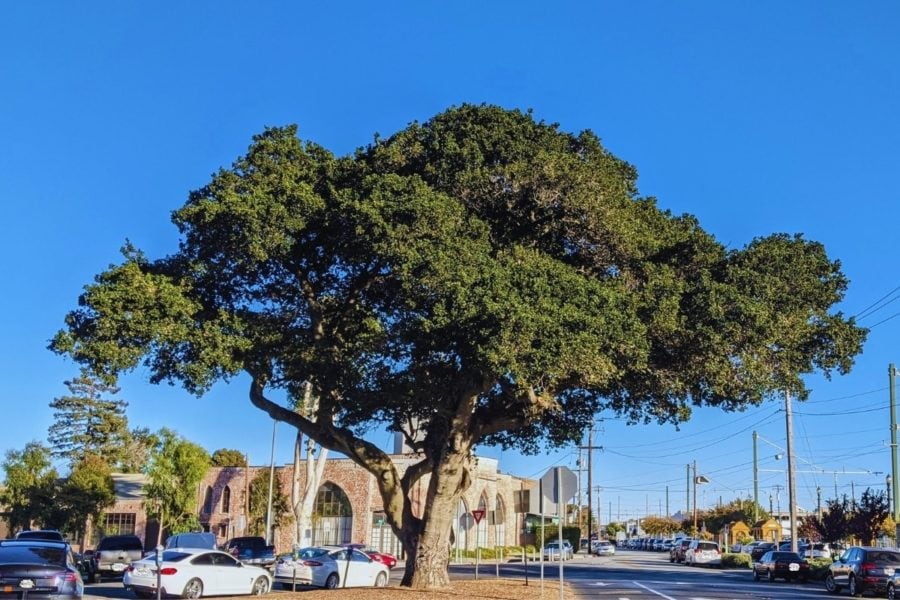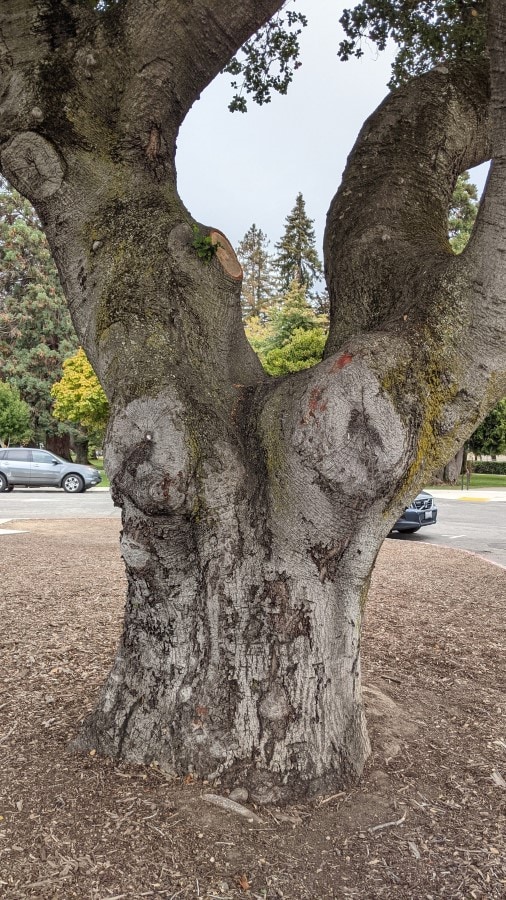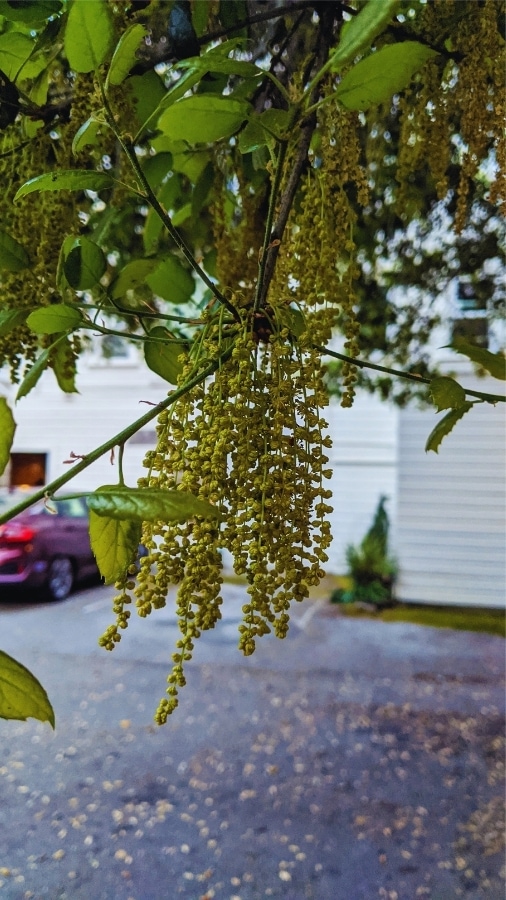In this article, we will learn to identify oak trees (scientific name: Quercus) as well as how and when their pollen spreads.
| Oak (Genus: Quercus) | Pollen allergy profile |
|---|---|
| Pollen season | Spring, Summer |
| Pollination type | Wind pollinated. Each tree releases a large amount of pollen into the air |
| Cross-reactivity with other pollen | Within the same family Fagaceae (Oak, Chestnut, Beech), but also possible with Betulaceae (Birch, Alder) |
| Pollen source | Male flowers (catkins) develop during winter and release pollen during spring or summer (see pictures below.) |
| Gender | Monoecious: Separate male and female flowers on the same tree. |
| Fruit | Acorns: Oaks are the only trees that produce acorns (see pictures below). |
| Leaves | Rounded lobs (white oaks) or Pointy lobs (red oaks), but other forms possible (see pictures below.) |
How to identify an oak tree (Genus: Quercus)?
The oak trees have over 450 species worldwide and about 60 of them are in the US alone.[3][R1] Identifying the exact species of an oak tree can be tricky because it hybridizes easily [R1]. Oak trees are found all over the US except Hawaii and Alaska [R1] and this is why oak tree allergies are common.
The most distinct feature of an oak tree is an acorn, its fleshy fruit with a scaly cap on the top. However, a tree has to be twenty to fifty years old to produce acorns. Thus, we have to learn to identify its leaves, which, as shown in the picture below, come in many sizes and shapes.
Some of the oak species are deciduous and some are evergreen (e.g. Coast live). Some do change color during autumn (e.g. Scarlet and Pin) and some remain green.
The leaves of oaks shown in the picture are all collected from an area within a 5-mile radius of my lab. This is how diverse looking this genus of the tree is.
Some species form the group called “Red oaks” and they have several lobes with pointy tips. The examples of species that fall in the “red oaks” category are Scarlet, Pin, and the Northern oaks (#4, 5,10 in the picture below).
Some species form the group called “White oaks” and they have several round-tipped lobes. The examples of “White oaks” are English and Valley oaks (#1 and 2 in the picture below).
There are other species such as Coast live, cork, Holly that do not neatly fit into the red or white oak groupings because they do not have leaves with multiple lobes. Most, however, will have tiny spikes on the edges of the leaves (#3,6,8,9 in the picture below)
Leaves and fruit
Tree size and shapes
With over 450 species in existence, it is rather difficult to describe oak trees. Some oak trees live up to their reputation and are indeed mighty, and some not so much.
Here are pictures of three different oak trees just as an example.
Bark and trunk
For an allergy sufferer, it is not practical to rely on the bark or trunk to identify an oak tree. The barks and trunks are so different from one tree to the other that it is not an easy trait to master. We leave that to the experts. I have found acorns and leaves to be enough to identify an oak tree.
But for the curious minds, here are examples of the bark of three different species of oak trees. As you can see, each one of them is remarkably different from the other.
During which months oak trees release pollen?
Different species of oak trees release pollen from early spring to early summer.
In the San Francisco bay area, oak pollen is found in our air surveys from Mar-15th to June-30th.
Even though each tree release pollen only for six to eight weeks, the overall oak pollen season lasts nearly four months because of the sequential blooming of different species. In Northern California, the coast live species start the oak pollen season in March, and Holly and cork oaks end the pollen season in June. Most other red and white oak species bloom during April and May.
Each year, the pollen season shifts a little bit due to weather conditions. Therefore it is useful to learn about the oak trees and their pollen-producing habits to be able to accurately predict the pollen season each year.
However, if you live in the San Francisco Bay Area, you have an easier way out! I do regular tree inspections and air sampling in the area to provide reliable pollen updates on our website
How does oak pollen spread?
Oak trees release pollen into the air and wind can carry the pollen many miles.
Since the tree is widely present in the mainland USA, its pollen is expected to be in the air surveys everywhere during spring and early summer.
When compared to other allergy plants, iIn most US cities, oak produces one of the largest pollen loads as well as the longest pollen season.
What does oak pollen look like?
The male catkins release pollen in the form of fine yellow powder. However, once the pollen disperses in the air, it becomes invisible to the naked eye.
Each oak pollen grain is around 30 micrometers (0.03 mm) in size and has three furrows. It has a warty exterior surface. Quercus pollen: Tricolpate (some scientific literature considers it tricolporate) with verrucate exine.
How do you know if oak tree is releasing pollen?
The tell-tale sign of an oak tree releasing pollen is the presence of male flowers (catkins) on its twigs. When the catkins first appear on the trees, they are like green beads hanging in groups (first picture) and are still too young to release pollen.
When the catkins turn yellow and have a brush-like appearance, they are mature and capable of releasing pollen (second picture).
Mature catkins eventually fall on the ground. If you suffer from oak tree allergies, be especially careful on days when the leaf blowers or street cleaners come and disturb these catkins on the ground.
Final thoughts
Oak (Genus: Quercus) is an important allergen in the US, and in the world, because of its widespread presence.
Furthermore, it belongs to the order Fagales, which means if you have oak tree allergies, it is possible for you to have allergies or cross-reactivity to other genera of the same order such as Birch, Alder, Walnut, and Casuarina[R4].
I have also written about Chinese Pistache (Pistacia chinensis), Sycamore (Platanus), Sweetgum (Liquidambar styraciflua), Hackberry (Cletis), and Olive (Olea Europaea) trees that release pollen at the same time as some of the species of oak.
Sources
- https://plants.usda.gov/
- http://dendro.cnre.vt.edu/dendrology/factsheets.cfm
- https://www.britannica.com/plant/oak
References
- Allergy Plants by Mary Jelks, M.D.
- Plant identification terminology by James G. Harris and Melinda Woolf Harris (Second Edition)
- Sampling and indentifying pollens and Molds by E. Grant Smith
- Hay Fever by Jonathan Brostoff, M.D and Linda Gamlin
All pictures, unless otherwise credited to another source, are taken by the author and are copyrighted material. The pollen picture is taken in our aerobiology lab using an Olympus compound microscope.












My husband and I plan to visit Branson Memphis and Nashville in October.
I have allergy to oak tree pollen.
Should I have any problems with pollen from oak trees in these cities.
Sheril Mandel
Hi Sheril – Although I do not do air sampling in Tennessee, I can tell you that Oak trees bloom in spring and some of them run into summer but never into fall. So, the risk of you encountering Oak pollen in Memphis or Nashville in October is minimal. That said, these cities may have other trees’ pollen that has similar proteins as Oak, which could possibly invoke an allergic reaction. Although the risk of such cross-reaction too is minimal, you should take with you any medicine that your doctor may have advised you to take. Having your meds with you will give you extra peace of mind just in case.
Wishing you a good trip!
Sudhir
I am a bee keeper and appreciate the oak pollen. You wrote a very good article and I appreciate your interest in pollen, even though you suffer from allergies.